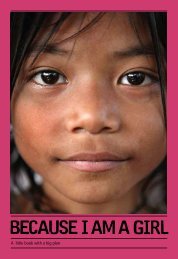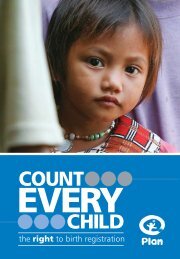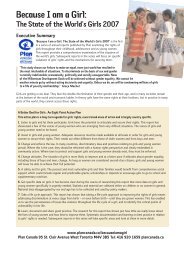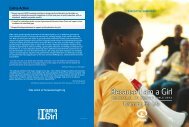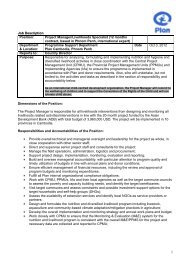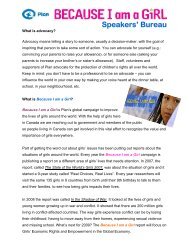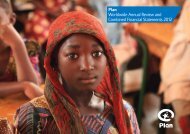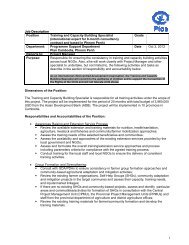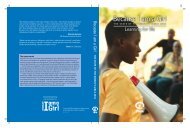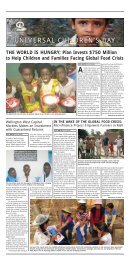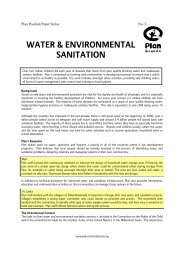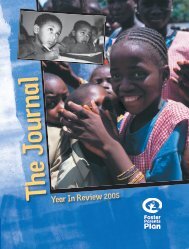Parce que je suis une fille - Droits des filles
Parce que je suis une fille - Droits des filles
Parce que je suis une fille - Droits des filles
Create successful ePaper yourself
Turn your PDF publications into a flip-book with our unique Google optimized e-Paper software.
Chapitre 2 (suite)<br />
Chapitre 2 (suite)<br />
exclusion in Afghanistan: Home-Best Schooling for Girls.<br />
“Critical Half” (Abord du problème de l’exclusion basé sur<br />
le genre en Afghanistan: l’école à la maison pour les <strong>fille</strong>s.<br />
“La moitié criti<strong>que</strong>”) Numéro spécial sur l’exclusion sexiste<br />
dans la reconstruction post-conflit: Women for Women<br />
International, vol. 3, n° 2, pages 26 à 31, 2006. (http://www.<br />
womenforwomen.org/repubbiannual.htm.)<br />
17 Enquête mondiale sur l’éducation dans les situations<br />
d’urgence, Commission <strong>des</strong> Femmes pour les femmes<br />
et les enfants réfugiés, février 2004. http://www.<br />
womenscommission.org/pdf/ed_Emerg.pdf<br />
18 Education dans les situations d’urgence: implications de<br />
genre pour les femmes http://www2.<strong>une</strong>scobkk.org/elib/<br />
publications/092/edu_emergencies_Low.pdf<br />
19 UNICEF 2000 Les deux visages <strong>des</strong> conflits ethni<strong>que</strong>s: vers<br />
<strong>une</strong> éducation <strong>des</strong> enfants à la consolidation de la paix.<br />
http://www.unicef.icdc.org/publications/pdf/insight4.pdf<br />
20 www.irinnews.org/Report.aspx?Reportid-5037<br />
21 Kirk, J. 2007, Learning for Peace and Equality ? Gender<br />
and Education in Contexts of Crises, post Crises and State<br />
Fragility (Apprendre pour la paix et l’égalité? Genre et<br />
éducation dans <strong>des</strong> contextes de crises, de post-crises et de<br />
fragilité étati<strong>que</strong>)<br />
22 Rapport de Vérité et Réconciliation pour les enfants de Sierra<br />
Leone, 2004, http://www.unicef.org/infobycountry/files/<br />
TRCCF9SeptFINAL.pdf<br />
23 OMS, 2006, Santé infantile dans les conflits armés. Le<br />
moment de la repenser, The Lancet, vol. 367, 10 juin 2006<br />
http://www.who.int/diseasecontrol_emergencies/MG_child_<br />
health_lancet.pdf<br />
24 Save the Children, 2003. Situation <strong>des</strong> mères dans le monde<br />
25 Citation dans Hynes, P.H. 2004, On the Battlefield of<br />
Women’s bodies: and overview of the Harm of War to<br />
Women, Women’s Studies International Forum, 27, 2004 (Sur<br />
le champ de bataille <strong>des</strong> corps <strong>des</strong> femmes: survol <strong>des</strong> maux<br />
causés par la guerre aux femmes) http://action.web.ca/<br />
home/catw/attach/Paper1OntheBattlefields.pdf<br />
26 Toole, M. J. et Waldman, R. J., The Public Health Aspect<br />
of Complex Emergencies and Refugee Situations, (Aspect<br />
de santé publi<strong>que</strong> dans les situations d’urgence complexes<br />
et pour les réfugiés) Annual Review of Public Health,<br />
1997, 18 (283-312) http://www.sasupenn.edu/-dludden/<br />
RefugeePublichealth,pdf<br />
27 UNICEF, 2005, État <strong>des</strong> enfants dans le monde, 2006 http://<br />
www.unicef.org/sowc06/pdfs/pub_adultwars_en.pdf<br />
28 Save the Children, Situation <strong>des</strong> mères dans le monde, 2002<br />
http://www.savethechildren.org/publications/mothers2002/<br />
sowm2002.pdf<br />
29 Situation <strong>des</strong> mères dans le monde 2007 Save the Children<br />
Fund<br />
30 “<strong>Droits</strong> à la naissance, nouvelles approches d’<strong>une</strong> maternité<br />
sûre” Panos 2001 :http://www.panos.org.uk/PDF/reports/<br />
BirthRightsSafeMotherhood.pdf<br />
31 UNFPA, http://www.unfpa.org/mothers/facts.htm<br />
32 UNFPA Faits concernant les maternités sûres. http://www.<br />
unfpa.org/mothers/facts.htm<br />
33 Transcription de UNFPA, mise à disposition de services de<br />
santé reproductive: UNFPA au Népal http://video.unfpa<br />
34 UNICEF, ‘VIH/SIDA : Conflits et déplacements’ (août 2006)<br />
page 3: http://data.unaids.org/pub/Report/2006/hiv_aids_<br />
conflict_displacement.pdf<br />
35 Pro<strong>je</strong>t du Millénaire <strong>des</strong> Nations Unies, La Lutte contre le<br />
SIDA dans le monde en développement, UNFPA 2005.<br />
36 ONUSIDA, 2007, mise à jour de l’épidémie de SIDA<br />
37 UNICEF 2006, État <strong>des</strong> enfants du monde, 2006<br />
38 Discours prononcé par Douglas Webb, UNICEF, réunion de<br />
l’initiative d’apprentissage conjointe sur les enfants et le SIDA<br />
(JLICA)-Boston, USA, (24 septembre 2007).<br />
39 Pharoah, R. et Weiss, T. 2005, Aids, Orphan, Crime and<br />
Instability. Exploring the linkages (Sida, orphelins, criminalité<br />
et instabilité: examen <strong>des</strong> liens) ISS Occasional Paper 107,<br />
juin 2005<br />
40 UNICEF, Le VIH/SIDA et les enfants: le SIDA et les conflits<br />
armés.<br />
41 ONUSIDA, 2000, Le VIH/SIDA en tant <strong>que</strong> problème de<br />
sécurité: perspective de genre.<br />
42 IRIN, Burundi: Les civils perdent la guerre, mai 2003<br />
43 Sagala, John K. “Le VIH/SIDA et les militaires en Afri<strong>que</strong><br />
subsaharienne; impact sur l’efficacité d’organisation<br />
militaire”. Africa Today, vol. 53 (1), automne 2006, pages 53<br />
à 77<br />
44 ONUSIDA Afri<strong>que</strong> subsaharienne, feuille de chiffres.<br />
45 http://www.unifem.org/attachments/products/216_<br />
chapter04.pdf “Les femmes, la guerre et la paix: évaluation<br />
d’experts indépendants sur l’impact <strong>des</strong> conflits armés sur<br />
les femmes et rôle <strong>des</strong> femmes dans la consolidation de<br />
la paix” (Progrès <strong>des</strong> femmes du monde, 2002, vol. 1) par<br />
Elisabeth Rehn, Hellen Johnson Sirleaf. Chapitre 4: VIH/<br />
SIDA, Les femmes et la guerre<br />
46 UNICEF Voix de <strong>je</strong><strong>une</strong>s, http:www.org/voy/explore/sowc/<br />
explore_ 1654.html<br />
47 Les Je<strong>une</strong>s et les conflits violents: la société et le<br />
développement en crise? PNUD 2006 http://www.undp.org/<br />
cpr/whats_nw/UNDP_Youth_PN.pdf<br />
48 Graça Machel, 1996<br />
49 49 Ibid<br />
50 Ibid<br />
51 Ibid<br />
52 Watts, S. et al. 2007, Déterminants sociaux de la santé<br />
dans les pays en conflit : la perspective de la Méditerranée<br />
orientale. OMShttp://www.who.int/social_determinants/<br />
resources/conflicts_and_sdh_07.pdf<br />
53 Ibid.<br />
54 McKay, S. & Mazurana, D. (2004) where are the Girls? Girls<br />
in Fighting Forces in Northern Uganda, Sierra Leone and<br />
Mozambi<strong>que</strong>. Their Lives During and After War (Où sont les<br />
<strong>fille</strong>s, les <strong>fille</strong>s dans les forces combattantes en Ouganda du<br />
nord, en Sierra Leone et au Mozambi<strong>que</strong>. Leurs vies pendant<br />
et après la guerre). Centre International <strong>des</strong> <strong>Droits</strong> Humains<br />
et du Développement Démocrati<strong>que</strong>, Montréal<br />
55 Denov, M. & MacLure, R. (2005) Child Soldiers in Sierra<br />
Leone : Experiences, Implications and Strategies for<br />
Community Reintegration (Enfants soldats en Sierra Leone:<br />
expériences, participations et stratégie de réintégration<br />
communautaire. Rapport de l’Agence Canadienne de<br />
Développement International<br />
56 Herman, Judith L. (1992) Trauma and Recovery (Traumatisme<br />
et rétablissement) Basic Books, N. Y.<br />
57 Graça Machel, 1996<br />
58 Richter, L. et al. 2006, Where the Heart is – Meeting the<br />
Psychosocial Needs of Young Children in the Context of<br />
HIV/AIDS (Où se trouve le coeur – Répondre aux besoins<br />
psychosociaux <strong>des</strong> <strong>je</strong><strong>une</strong>s enfants dans le contexte du VIH/<br />
SIDA) Bernard van Leer Foundation<br />
59 Coalition to Stop the Youth of Child Soldiers, 2000, Girls<br />
with Guns: and Agenda on Child Soldiers for Beijing plus<br />
five (Coalition pour <strong>que</strong> cesse l’utilisation d’enfants soldats,<br />
2000. Des <strong>fille</strong>s avec <strong>des</strong> fusils: un programme pour les<br />
enfants soldats pour Beijing plus. http:// www.essex.ac.uk/<br />
armedcon/story_id/000050.pdf<br />
60 Coalition to Stop the Youth of Child Soldiers, 2000 (Coalition<br />
pour <strong>que</strong> cesse l’utilisation d’enfants soldats).<br />
61 McKay, S. & Mazurana, D. (2004) where are the Girls? Girls<br />
in Fighting Forces in Northern Uganda, Sierra Leone and<br />
Mozambi<strong>que</strong>. Their Lives During and After War (Où sont les<br />
<strong>fille</strong>s, les <strong>fille</strong>s dans les forces combattantes en Ouganda du<br />
nord, en Sierra Leone et au Mozambi<strong>que</strong>. Leurs vies pendant<br />
et après la guerre). Centre International <strong>des</strong> <strong>Droits</strong> Humains<br />
et du Développement Démocrati<strong>que</strong>, Montréal<br />
62 “La violence contre les <strong>fille</strong>s en Afri<strong>que</strong> pendant les conflits<br />
armés et les crises” Deuxième Conférence de politi<strong>que</strong><br />
internationale sur l’enfant africain: violence envers les <strong>fille</strong>s en<br />
Afri<strong>que</strong>. CICR et le Forum sur la politi<strong>que</strong> de l’enfant africain.<br />
2006. http://www.icrc.org/Web/Eng/siteeng0.nsf/htmlall/<br />
violence-girls-conference-110506/$File/International-Policy-<br />
Coference.pdf<br />
63 ‘Genre, conflit et développement‘ Ban<strong>que</strong> Mondiale, 2005<br />
http://www-wds.worldbank.org/seviet/WDSContentServer/<br />
WDSP/IB/2004/11/15/000090341_20041115142901/<br />
Rendered/PDF/30494.pdf<br />
64 Cette composition est tirée <strong>des</strong> <strong>des</strong>criptions données sur<br />
les activités quotidiennes, les missions et les formations, à<br />
partir d’interviews conduites avec <strong>des</strong> <strong>fille</strong>s du Sri Lanka.<br />
Dans Keairns Y. ‘Les voix <strong>des</strong> enfants soldats <strong>fille</strong>s : résumé‘<br />
Bureau <strong>des</strong> Quakers aux Nations Unies, 2002. http://www.<br />
quno.org/newyork/Resources/QUNOchildsoldiers.pdf<br />
65 Ban<strong>que</strong> Mondiale 2005. « Genre, conflit et développement ».<br />
http://www.wds.worldbank.org/serviet/WDSContentServer/<br />
WDSP/IB/2004/11/15/000090341_20041115142901/<br />
Rendered/PDF/30924.pdf<br />
66 Ibid.<br />
67 Ibid.<br />
68 Keairms Y. ‘Les voix <strong>des</strong> enfants soldats <strong>fille</strong>s : résumé‘<br />
Bureau <strong>des</strong> Quakers aux Nations Unies, 2002 http://www.<br />
quno.org/newyork/Resources/QUNOchildsoldiers.pdf<br />
69 McKay, S. & Mazurana, D. (2004) Where Are the Girls? Girls<br />
in Fighting Forces in Northern Uganda, Sierra Leone and<br />
Mozambi<strong>que</strong>. Their Lives During and After War (Où sont les<br />
<strong>fille</strong>s, les <strong>fille</strong>s dans les forces combattantes en Ouganda<br />
du nord, en Sierra Leone et au Mozambi<strong>que</strong>. Leurs vies<br />
pendant et après la guerre).http://www.ddrd.ca/site/_PDF/<br />
publicatioons/women/girls_whereare.pdf<br />
70 Recherche faites en Ouganda par Alinson Cole pour Amnesty<br />
International<br />
71 Brett R. et Specht, I. ‘Young Soldiers: Why they Choose<br />
to Fight’ (Les <strong>je</strong><strong>une</strong>s soldats: pourquoi ils ont choisi de se<br />
battre.) Lynne Rienner Publishers, 2004<br />
72 Coalition to Stop the Youth of Child Soldiers, 2000, Girls<br />
with Guns: and Agenda on Child Soldiers for Beijing plus five<br />
(Coalition pour <strong>que</strong> cesse l’utilisation d’enfants soldats, 2000.<br />
Des <strong>fille</strong>s avec <strong>des</strong> fusils: un programme pour les enfants<br />
soldats pour Beijing plus cinq). http://www.essex.ac.uk/<br />
armedcon/story_id/000050.pdf<br />
73 Human Rights Watch, 2007 Early to War : Child Soldiers<br />
in Chad Conflict (Tôt à la guerre: enfants soldats dans le<br />
conflit du Tchad) http://hrw.org/reports/2007/chad0707/<br />
chad0707web.pdf<br />
74 Les Je<strong>une</strong>s et les conflits violents : la société et le<br />
développement en crise ? PNUD 2006. http://www.undp.org/<br />
cpr/whats_new/UNDP_Youth_PN.pdf<br />
75 Save the Children, 2005 ‘Victimes oubliées de la guerre: les<br />
<strong>fille</strong>s dans les conflits armés’ http://www.harare.<strong>une</strong>sco.org/<br />
women/2698_GAAF%20report.pf.p.18<br />
76 Ibid.<br />
77 Brett R. et Specht, I. ‘Young Soldiers : Why they Choose<br />
to Fight’ (Les <strong>je</strong><strong>une</strong>s soldats: pourquoi ils ont choisi de se<br />
battre) Lynne Rienner Publishers, 2004<br />
78 Ibid.<br />
79 Specht I. ‘Red Shoes, Experiences of Girl Combatants in<br />
Liberia’ (Souliers rouges, expériences <strong>des</strong> enfants soldats<br />
<strong>fille</strong>s au Liberia) Organisation Internationale du Travail http://<br />
www.ilo.org/public/english/employment/crisis/download/<br />
redshoes.pdf<br />
80 ‘Arms to Fight, Arms to Protect : Women Speak out about<br />
Conflict‘ (Des armes pour se battre, <strong>des</strong> armes pour<br />
protéger: <strong>des</strong> femmes parlent <strong>des</strong> conflits) O. Bennett, J.<br />
Bexley, K. Warnock, Panos London, 2005<br />
81 Yvonne Kealms, The voices of Girl Childsoldiers (Voix <strong>des</strong><br />
enfants soldats <strong>fille</strong>s)<br />
http://www.quno.org/newyork/Resources/<br />
QUNOchildsoldiers.pdf UN Quaker Office, 2002.<br />
82 Specht I. ‘Red Shoes, Experiences of Girl Combatants in<br />
Liberia’ (Souliers rouges, expériences <strong>des</strong> enfants soldats<br />
<strong>fille</strong>s au Liberia) Organisation Internationale du Travail http://<br />
www.ilo.org/public/english/employment/crisis/download/<br />
redshoes.pdf<br />
83 Myriam Denov “Girls and Fighting Forces: Moving beyond<br />
Victimhood” (Les <strong>fille</strong>s dans les forces combattantes: au-delà<br />
de l’état de victime) (2007, CIDA) http://www.crin.org/docs/<br />
CIDA_Beyond_forces.pdf<br />
84 Specht I. ‘Red Shoes, Experiences of Girl Combatants in<br />
Liberia’ (Souliers rouges, expériences <strong>des</strong> enfants soldats<br />
<strong>fille</strong>s au Liberia) Organisation Internationale du Travail. http://<br />
www.ilo.org/public/english/employment/crisis/download/<br />
redshoes.pdf<br />
85 Ban<strong>que</strong> Mondiale 2005. ‘Genre, conflit et développement’<br />
http://www-wds.worldbank.org/serviet/WDSContentServer/<br />
WDSP/IB/2004/11/15/000090341_20041115142901/<br />
Rendered/PDF/30494.pdf<br />
86 UNICEF 2006, État <strong>des</strong> enfants du monde 2006. ,http://www.<br />
unicef.org/sowc06/pdfs/pub_adultwars_en.pdf<br />
87 RAND Corporation, The Bomber behind the Veil (Le<br />
Kamikaze derrière le voile)<br />
http://www.rand.org/commentary/121305BS.html<br />
88 Debra D. Zedalis, Female Suicide Bombers<br />
(Commandos suici<strong>des</strong> féminins) ISS, 2004,http://www.<br />
strategicstudiesinstitute.army.mil/pdffiless/PUB408pdf<br />
89 Margo Harakas “Palestinian Women Defy Islamic Tradition<br />
to Become Suicide Bombers” (Les femmes palestiniennes<br />
défient la tradition islami<strong>que</strong> pour devenir commando<br />
suicide) Sun-Sentinel, 15 avril 2002<br />
90 The Daily Telegraph, 26 juillet 2006, “My Dream Was to Be a<br />
Suicide Bomber » (Je rêvais de devenir commando suicide)<br />
http://www.telegraph.co.uk/news/main.jhtml?xml=/news/<br />
éàà(/06/26/wmld26.xml1page=2<br />
91 Situation <strong>des</strong> mères du monde 2003 Save the Children<br />
92 Specht I. ‘Red Shoes, Experiences of Girl Combatants in<br />
Liberia’ (Souliers rouges, expériences <strong>des</strong> enfants soldats<br />
<strong>fille</strong>s au Liberia) Organisation Internationale du Travail http://<br />
www.ilo.org/public/english/employment/crisis/download/<br />
redshoes.pdf<br />
93 Blattman C., Annan J. et Horton R., ‘Résumé exécutif du<br />
rapport final sur l’enquête concernant les <strong>je</strong><strong>une</strong>s affectés par<br />
la guerre: Phase I 2006’, www.sway-uganda.org<br />
94 Myriam Denov, Child soldiers in Sierra Leone – experiences,<br />
implications ans strategies for rehabilitation and Community<br />
reintegration, (Enfants soldats en Sierra Leone: expériences,<br />
implications et stratégies de réintégration) Agence<br />
Canadienne de Développement International, (CIDA) Août 2005<br />
95 Ibid<br />
96 BBC News, 26 août 2003, cité dans http://wwww.icrc.org/<br />
Web/Eng/siteeng0nsf/htmlall/violence-girls-conference-<br />
110506/$File/International-PolicyConference.pdf<br />
97 Save the Children, Rapport trimestriel, District de Kambia,<br />
Sierra Leone, octobre 2004 (non publié) dans ‘Victimes<br />
oubliées de la guerre; les <strong>fille</strong>s dans les conflits armés’,<br />
Save the clildren Fund.<br />
98 Holst-Roness, F., 2006 “La violence contre les <strong>fille</strong>s en<br />
Afri<strong>que</strong> pendant les conflits armés et les crises” CICR,<br />
Communication à la Deuxième Conférence de politi<strong>que</strong><br />
internationale sur l’enfant africain: Mai 2006. http://www.icrc/<br />
Web/Eng/siteeng0.nsf/htmlall/violence-girls-conference-<br />
110506/$File/International-Policy-Conference.pdf<br />
99 Le Rapport Warburton, Communauté européenne, 1993.<br />
100 ICTY Verdict de la Chambre correctionnelle II dans l’affaire<br />
Kunarac Kovac et Vukovic, JL/P.I..S./566-e, 22 février 2001<br />
152 the state of the world’s girls REFERENCES 153



